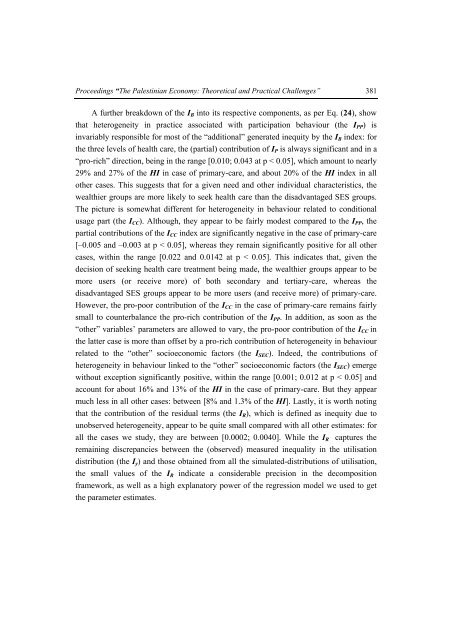The Palestinian Economy. Theoretical and Practical Challenges
The Palestinian Economy. Theoretical and Practical Challenges
The Palestinian Economy. Theoretical and Practical Challenges
You also want an ePaper? Increase the reach of your titles
YUMPU automatically turns print PDFs into web optimized ePapers that Google loves.
Proceedings “<strong>The</strong> <strong>Palestinian</strong> <strong>Economy</strong>: <strong>The</strong>oretical <strong>and</strong> <strong>Practical</strong> <strong>Challenges</strong>” 381<br />
A further breakdown of the I B into its respective components, as per Eq. (24), show<br />
that heterogeneity in practice associated with participation behaviour (the I PP ) is<br />
invariably responsible for most of the “additional” generated inequity by the I B index: for<br />
the three levels of health care, the (partial) contribution of I P is always significant <strong>and</strong> in a<br />
“pro-rich” direction, being in the range [0.010; 0.043 at p < 0.05], which amount to nearly<br />
29% <strong>and</strong> 27% of the HI in case of primary-care, <strong>and</strong> about 20% of the HI index in all<br />
other cases. This suggests that for a given need <strong>and</strong> other individual characteristics, the<br />
wealthier groups are more likely to seek health care than the disadvantaged SES groups.<br />
<strong>The</strong> picture is somewhat different for heterogeneity in behaviour related to conditional<br />
usage part (the I CC ). Although, they appear to be fairly modest compared to the I PP , the<br />
partial contributions of the I CC index are significantly negative in the case of primary-care<br />
[–0.005 <strong>and</strong> –0.003 at p < 0.05], whereas they remain significantly positive for all other<br />
cases, within the range [0.022 <strong>and</strong> 0.0142 at p < 0.05]. This indicates that, given the<br />
decision of seeking health care treatment being made, the wealthier groups appear to be<br />
more users (or receive more) of both secondary <strong>and</strong> tertiary-care, whereas the<br />
disadvantaged SES groups appear to be more users (<strong>and</strong> receive more) of primary-care.<br />
However, the pro-poor contribution of the I CC in the case of primary-care remains fairly<br />
small to counterbalance the pro-rich contribution of the I PP . In addition, as soon as the<br />
“other” variables’ parameters are allowed to vary, the pro-poor contribution of the I CC in<br />
the latter case is more than offset by a pro-rich contribution of heterogeneity in behaviour<br />
related to the “other” socioeconomic factors (the I SEC ). Indeed, the contributions of<br />
heterogeneity in behaviour linked to the “other” socioeconomic factors (the I SEC ) emerge<br />
without exception significantly positive, within the range [0.001; 0.012 at p < 0.05] <strong>and</strong><br />
account for about 16% <strong>and</strong> 13% of the HI in the case of primary-care. But they appear<br />
much less in all other cases: between [8% <strong>and</strong> 1.3% of the HI]. Lastly, it is worth noting<br />
that the contribution of the residual terms (the I R ), which is defined as inequity due to<br />
unobserved heterogeneity, appear to be quite small compared with all other estimates: for<br />
all the cases we study, they are between [0.0002; 0.0040]. While the I R captures the<br />
remaining discrepancies between the (observed) measured inequality in the utilisation<br />
distribution (the I y ) <strong>and</strong> those obtained from all the simulated-distributions of utilisation,<br />
the small values of the I R indicate a considerable precision in the decomposition<br />
framework, as well as a high explanatory power of the regression model we used to get<br />
the parameter estimates.
















